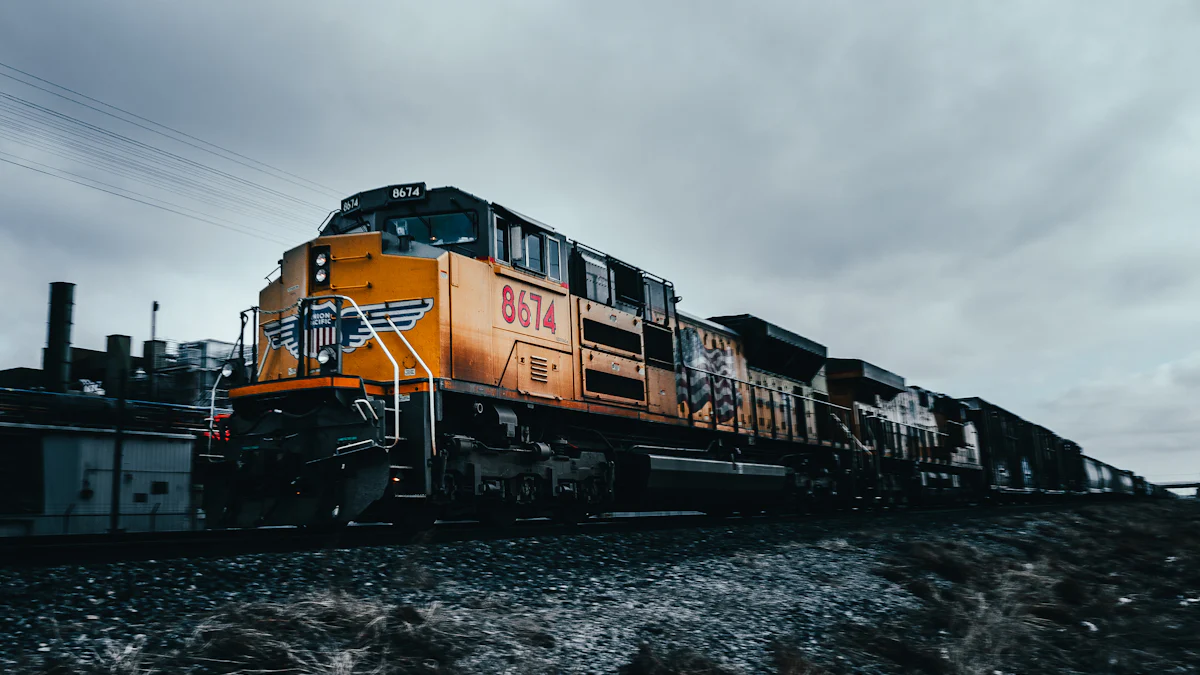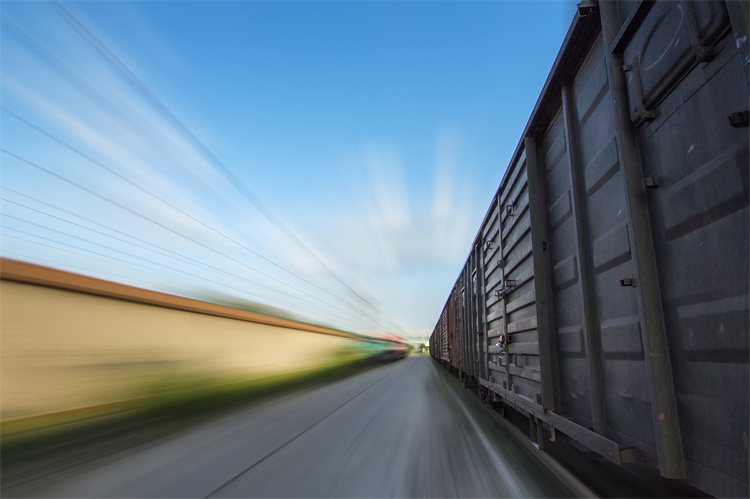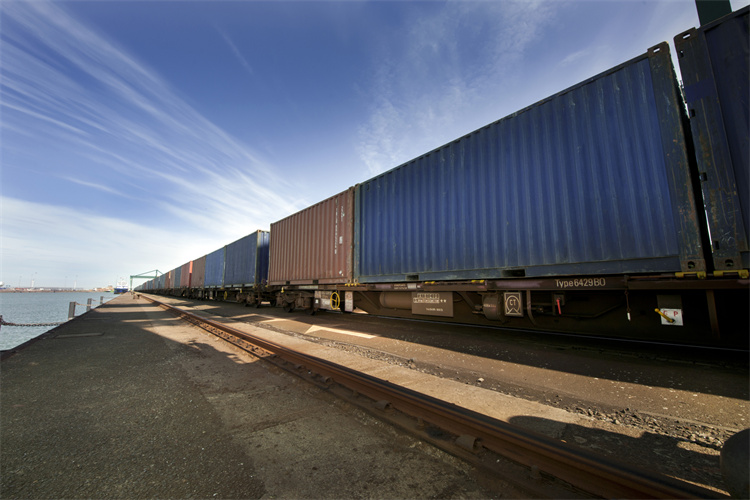Full Steam Ahead: American's Trailblazing Path in Rail Logistics

Railroads have played a pivotal role in shaping American commerce. The vast network of nearly 140,000 miles dedicated to freight rail underscores its dominance in the logistics sector. Freight rail contributes over 95% of total rail transportation revenues, highlighting its economic significance. The transformative journey of railroads continues as technology enhances safety and minimizes environmental impact. Companies like JUSDA leverage extensive networks and strategic partnerships to offer comprehensive rail transport solutions. These efforts ensure efficient and reliable logistics, reinforcing the enduring impact of railroads on American commerce.
Historical Context of U.S. Railroads
The Birth of Railroads in America
Early Developments and Innovations
The early 19th century witnessed the dawn of railroads in America. Engineers and visionaries embarked on ambitious projects to connect distant regions. The construction of the Transcontinental Railroad marked a pivotal moment. This monumental achievement opened the West for settlement and economic opportunities. New towns and communities flourished along the tracks. The railroad industry spurred innovation, with advancements in steam technology and track design. These innovations laid the foundation for a vast and efficient transportation network.
Key Figures and Companies
Prominent figures emerged as pioneers in the railroad industry. Cornelius Vanderbilt and Leland Stanford played crucial roles in expanding rail networks. Vanderbilt's investments in railroads transformed regional lines into major systems. Stanford's involvement in the Central Pacific Railroad facilitated the completion of the Transcontinental Railroad. Companies like the Union Pacific and Central Pacific became powerhouses in the industry. These entities drove competition and fueled the rapid growth of rail infrastructure.
The Golden Age of Railroads
Expansion and Economic Impact
The late 19th century heralded the Golden Age of railroads. Massive expansion projects connected cities and rural areas across the nation. Railroads became the backbone of American commerce. The industry stimulated manufacturing and agriculture by providing efficient transport for goods. Railroads facilitated the movement of raw materials to factories and finished products to markets. The economic impact was profound, with railroads contributing significantly to national growth.
Railroads and Industrialization
Railroads played a vital role in the industrialization of America. The efficient transportation of coal, steel, and other resources powered factories. Urban centers expanded as railroads connected them to supply chains. Labor unions formed in response to the growing workforce in the railroad industry. Large trusts emerged, necessitating regulation to ensure fair practices. The development of local railroad networks increased standardization and cooperation among companies. This era marked a transformative period in American history, with railroads at the heart of industrial progress.
Decline of Railroads
Factors Leading to Decline
Rise of Automobile and Air Travel
The rise of automobiles marked a significant shift in American transportation. People embraced cars for personal travel due to convenience and flexibility. Roads and highways expanded rapidly, connecting cities and rural areas. The automobile industry experienced unprecedented growth, drawing investments away from railroads. Air travel emerged as a fast alternative for long-distance journeys. Airlines offered speed and efficiency, attracting business travelers and tourists. Railroads faced stiff competition from these emerging modes of transport.
Economic and Regulatory Challenges
Economic factors played a crucial role in the decline of railroads. High interest rates increased operational costs for railroad companies. The demand for coal, a major freight commodity, decreased significantly. Railroads struggled to adapt to changing economic conditions. Regulatory challenges further compounded the difficulties. Government regulations imposed restrictions on pricing and service offerings. Railroads found it challenging to compete with deregulated industries. The strategic landscape for rail transportation became increasingly complex.
Impact on American Commerce
Shifts in Transportation and Trade
The decline of railroads led to shifts in transportation patterns. Trucks and airplanes gained prominence in freight transport. Businesses relied on road and air networks for faster deliveries. Railroads lost market share in key sectors like manufacturing and agriculture. The logistics industry underwent a transformation with new technologies. Digital solutions enhanced efficiency and tracking capabilities. Companies like JUSDA leveraged multimodal transport to stay competitive. JUSDA's extensive rail network covered over 30 countries, offering comprehensive solutions.
Consequences for Industries
Industries faced significant consequences due to the decline of railroads. Manufacturing sectors experienced disruptions in supply chains. The movement of raw materials and finished goods became less efficient. Agricultural producers encountered challenges in transporting crops to markets. Railroads had previously provided cost-effective options for bulk shipments. The decline impacted the overall economic growth of the United States. Investments in public transportation became essential for revitalization. Sustainable and accessible modes of transport emerged as priorities for the future.
Modern Revival Efforts

Technological Advancements
High-Speed Rail Initiatives
High-speed rail initiatives have gained momentum in the United States. These projects aim to enhance passenger travel efficiency. The focus lies on reducing travel time between major cities. High-speed trains offer a sustainable alternative to air travel. These trains contribute to lower emissions and energy consumption. The American Rescue Plan Act (ARPA) has allocated funds for these projects. This funding supports the development of high-speed rail infrastructure.
Innovations in Rail Technology
Innovations in rail technology continue to transform the industry. Advanced monitoring systems ensure safety and efficiency. Real-time tracking of trains enhances operational capabilities. JUSDA's rail services exemplify these technological advancements. Their services include real-time monitoring of temperature and humidity. These innovations improve cargo safety and reliability. Energy-saving technologies contribute to emission reduction. The focus on green transportation aligns with climate goals.
Policy and Investment
Government Support and Funding
Government support plays a crucial role in rail revival efforts. Funding initiatives aim to improve rail infrastructure. The American Rescue Plan Act (ARPA) provides financial assistance. This support targets public transportation and Amtrak. Investments focus on enhancing passenger rail services. Improved rail systems contribute to economic growth. Efficient rail networks facilitate the movement of goods and people.
Public-Private Partnerships
Public-private partnerships drive innovation in the rail sector. Collaboration between government and private entities boosts investment. These partnerships fund critical rail projects across the nation. JUSDA's strategic partnerships exemplify successful collaboration. Their partnerships ensure stable carriage capacity and cabin availability. Customized special trains cater to diverse transportation needs. These efforts enhance the overall efficiency of rail networks. Public-private initiatives foster sustainable rail development.
Current Developments and Future Prospects

Transformative Journey in Rail Transport
Emerging Trends in Rail Transport
Rail transport has embarked on a transformative journey, embracing new trends that redefine its role in commerce. Automation plays a pivotal role in enhancing network efficiency and safety. Automated train operations reduce accidents related to human factors. This advancement provides fuel efficiency and air emissions benefits. Rail companies invest billions annually to streamline logistics and operations. These investments lead to increased productivity and competitiveness for businesses. JUSDA exemplifies this trend by offering comprehensive rail transport solutions. Their services include full-container and less-than-container-load options via China-Europe block trains.
Sustainability and Environmental Impact
Sustainability remains a key focus in modern rail transport. Rail companies recognize the importance of reducing their carbon footprint. Freight rail invests significantly in energy-saving and emission reduction initiatives. Rail transportation reinvests almost one in every five dollars of revenue. This commitment surpasses comparable industries. Passenger rail developments contribute to climate goals by offering efficient and sustainable transportation options. High-speed rail projects aim to lower emissions and energy consumption. JUSDA emphasizes green transportation through energy-saving technologies. Their real-time monitoring capabilities enhance cargo safety and reliability.

JUSDA Solutions
To provide you with professional solutions and quotations.
Future of Railroads in American Commerce
Integration with Other Modes of Transport
The integration of railroads with other modes of transport shapes the future of American commerce. Multimodal transport solutions offer flexibility and efficiency. Rail networks connect seamlessly with road, water, and air transport systems. This integration facilitates the movement of goods across vast distances. JUSDA specializes in international Eurasian sea-rail intermodal transport. Their extensive rail network covers over 30 countries, ensuring stable carriage capacity. Strategic partnerships with key train platforms enhance operational capabilities. Customized special trains cater to diverse transportation needs.
Potential Economic Benefits
Railroads hold significant potential for economic benefits in American commerce. Reliable and cost-effective rail transportation boosts business growth. Efficient rail networks facilitate the movement of raw materials and finished products. Passenger rail improvements have second-order effects on land use changes. These developments stimulate economic activity in urban centers. Investments in rail infrastructure contribute to national growth. JUSDA's rail services handle over 10,000 standard containers annually. Their operations span more than 30 countries, reinforcing their economic impact.
Challenges and Opportunities
The future of railroads presents both challenges and opportunities. Regulatory frameworks must adapt to evolving transportation needs. Rail companies face competition from other modes of transport. The rise of automobiles and air travel poses challenges for railroads. However, technological advancements offer opportunities for growth. Innovations in rail technology enhance safety and efficiency. Public-private partnerships drive investment in critical rail projects. Government support plays a crucial role in rail revival efforts. The American Rescue Plan Act (ARPA) allocates funds for high-speed rail initiatives. These efforts aim to revitalize rail transport and ensure its continued relevance.
Railroads have historically shaped American commerce by enhancing productivity and competitiveness. The integration of technology in rail transport ensures safety and minimizes environmental impacts. Companies like JUSDA exemplify this with comprehensive services and strategic partnerships. Sustainable transportation remains crucial for a decarbonized nation, and railroads play a pivotal role in this transformation. The future of railroads promises a resurgence in public transportation systems. Railroads will continue to drive economic growth and support environmental goals. The ongoing evolution of rail transport reflects its enduring significance in reshaping commerce.
See Also
Transforming Supply Chain Operations Through Big Data and AI
Industry Transformation: The Impact of Cloud Supply Chain Solutions
Innovative Logistics: Transforming the Supply Chain Landscape
2024 Revealed: The Latest Trends in Sea Freight Logistics
Ready for Change: Discovering the Latest in Supply Chain Technology
